Florida, a state known for its vast biodiversity, is a magnificent playground for bird watchers and nature enthusiasts alike. Among its extensive variety of avian inhabitants, hawks in Florida hold a particularly notable position. These splendid birds of prey in Florida are revered for their predatory prowess, striking appearance, and majestic flight.
Types of Hawks in Florida
Red-shouldered Hawk – Commonly found throughout Florida, they are typically seen in forests and swamp areas, including the Everglades National Park. Their distinctive, kee-rah call is often heard before they are seen.
Red-tailed Hawk – The Red-tailed Hawk is another common sight in Florida. They prefer open areas with high perching places, such as trees and utility poles. They are frequently seen in the Ocala National Forest.
Cooper’s Hawk – Cooper’s Hawks are often found in Florida’s woodlands and forests, such as the Apalachicola National Forest. Although they’re less abundant than the Red-shouldered and Red-tailed Hawks, they’re still fairly common.
Broad-winged Hawk – Broad-winged Hawks are a frequent sight during the migration season in Florida. They can be seen in great numbers in the Everglades during their fall migration.
Sharp-shinned Hawk – Sharp-shinned Hawks are somewhat elusive and primarily found in dense forests across Florida. Despite their relative scarcity, they are regularly spotted in Florida’s birding hotspots like the Merritt Island National Wildlife Refuge.
Northern Harrier – Also known as the Marsh Hawk, the Northern Harrier can be seen in open habitats such as marshes and grasslands in Florida. It’s less common than other hawks, but birders may spot them at the St. Marks National Wildlife Refuge.
Short-tailed Hawk – Short-tailed Hawks are rare but they are resident in Florida, particularly in the southern parts of the state. Their preferred habitat is in the subtropical highland forests like those found in the Big Cypress National Preserve.
Swainson’s Hawk – Although the Swainson’s Hawk is not resident in Florida, it passes through the state during its long migration from South America to North America. Sightings are rare, but possible, especially during the spring migration period.
White-tailed Hawk – White-tailed Hawks are relatively rare in Florida. Sightings are more likely in the southernmost regions of the state, such as the Florida Keys. Their preference for open grasslands and prairies makes spotting them a challenging but rewarding experience.
Northern Goshawk – Northern Goshawks are extremely rare in Florida, with only occasional sightings reported. They are more commonly found in northern regions, but some birders have reported sightings during migration periods.
Rough-legged Hawk – Rough-legged Hawks are rare visitors to Florida. They typically live in the Arctic and only venture this far south during the harshest winter months. Birders may have a slim chance of spotting these hawks in Florida’s northernmost regions.
Ferruginous Hawk – Ferruginous Hawks are the least common hawk in Florida. They typically inhabit the Western part of North America and sightings in Florida are extremely rare. The vast open grasslands of their typical habitat are not commonly found in Florida, making the state less appealing for these large hawks.
Florida’s Hawks Photo Guide
Red-tailed Hawk (Buteo jamaicensis)

The Red-tailed Hawk is a large bird of prey that is commonly found across North America. This species is part of the genus Buteo, which is often referred to as the “true hawks,” and includes more than two dozen species of raptors.
Red-tailed Hawks have a robust size, ranging from 18 to 26 inches in length and sporting a wingspan that can exceed 4 feet. They have a broad, rounded set of wings and a short, wide red tail. This species is most easily recognized by its rich, rust-colored tail, which gives it its common name. However, juvenile hawks might not yet have this distinctive feature.
Their feathers are generally dark brown on their dorsal side (back) with a lighter, often speckled, ventral side (front). The intensity and pattern of their plumage can vary significantly based on their age and geographic location, as there are about 14 recognized subspecies of Red-tailed Hawks.
As for their diet, Red-tailed Hawks are carnivores and have a broad diet that includes rodents, ground rabbits, reptiles, and other birds. They are skilled hunters that typically sit on high perches and use their keen eyesight to spot potential prey. Once they have identified a target, they swoop down to capture it with their powerful talons.
Red-tailed Hawks mate for life and build nests high off the ground, often in tall trees or on cliff edges. Their nests are made of sticks and can be quite large. They typically lay 1-3 eggs per year, which are incubated by both parents.
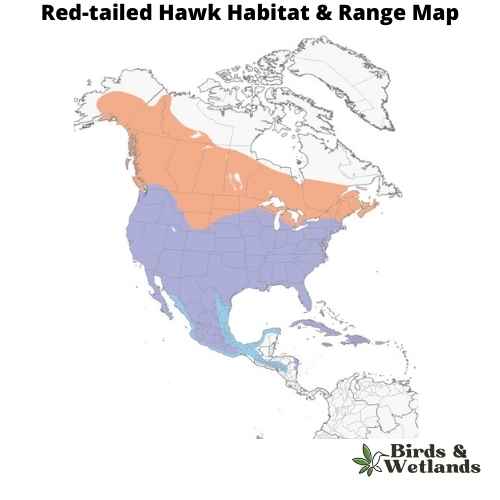
Red-tailed Hawk Sound
Red-shouldered Hawk (Buteo lineatus)

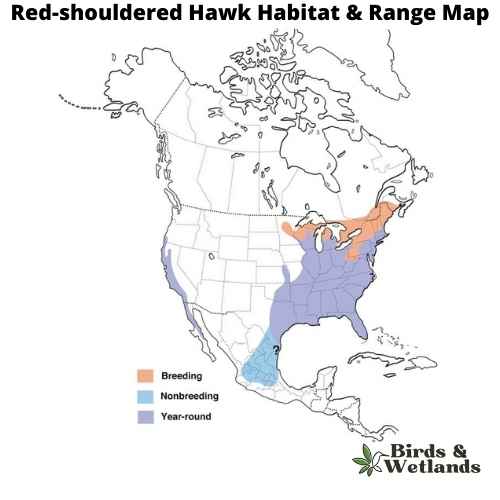
Listen:
The red-shouldered hawk are medium sized birds of prey, part of the buteo hawks family. It can be distinguished from other hawks by its reddish iris and pale legs.
The adult has rusty red upperparts, white underparts, a black chin and throat, and a reddish brown stripe over each eye, reddish brown heads and a strongly banded tail. The tail is reddish brown with two paler bands across it and they have white checkered wings. Juveniles are brown with dark barring and have pale fringes on the feathers of their wings.
Red-shouldered hawks nest in trees, though they also inhabit manmade structures including barns, bridges, and buildings. They prefer wooded areas with an open canopy but will use other places as well for nesting such as shrubs and hedges if needed.
The red-shouldered hawk’s diet – they eat small mammals such as ground squirrels, rabbits, voles, mice and rats. They also eat birds such as quail, pigeons and doves; reptiles including snakes; amphibians; fish; crustaceans; insects; and carrion (dead animals).
Cooper’s Hawk (Accipiter cooperii)

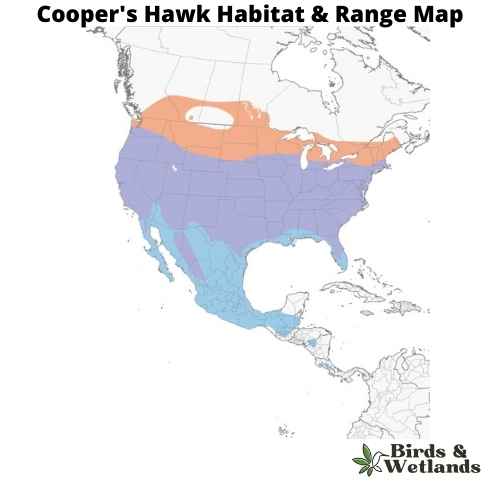
Listen:
The Cooper’s Hawk is a medium-sized bird of prey native to North America. Known for its agility and speed, it is part of the Accipitridae hawk species, which also includes other hawks, eagles, and kites.
Cooper’s Hawks are typically about 14 to 20 inches in length, with a wingspan ranging from 27 to 36 inches. They are known for their distinctive long, rounded tails and short, rounded wings. They have a steely blue gray top, with rusty bars on their underparts and thick, dark bands on their tails.
The Cooper’s Hawk is a skilled predator, primarily hunting birds and small mammals. They are adept at hunting in both dense forests and open areas, often catching prey mid-air in high-speed pursuits. They have also been known to visit the backyard bird feeder, not for the seed, but to prey on the smaller birds that gather there.
Cooper’s Hawks often build nests in dense tree canopies where they are well concealed. The female usually lays 3 to 5 eggs, and both parents share incubation duties. The young hawks fledge after about a month but will stay close to the nest, relying on their parents for food as they learn to hunt.
Sharp-shinned Hawk (Accipiter striatus)

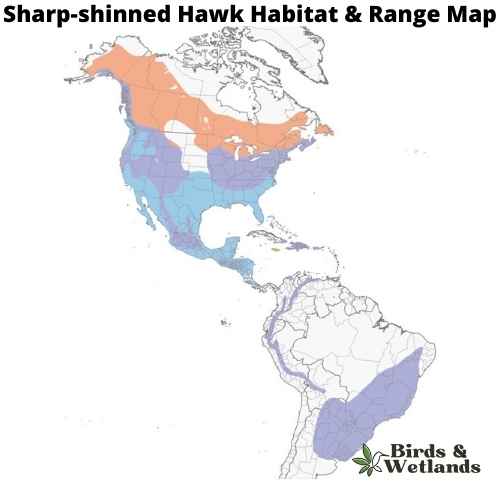
Listen:
The adult bird is brown on top and white underneath, with a dark brown band across its chest. It has short, rounded wings and a long tail that makes it look larger than it actually is. Adult sharp shinned hawks have black eyes, which are surrounded by white feathers. The female Sharp-shinned Hawk is browner than the male, who has darker brown markings on his back.
Sharp-shinned Hawks prefer open country for their habitat, including fields and meadows where they can hunt for mice and other small animals. They can be found throughout the United States but are most common in the east.
Sharp-shinned Hawks eat mostly small birds, such as sparrows and warblers, as well as small mammals such as mice and gophers. They catch prey by surprise using their incredible speed and agility, diving out of the sky at speeds up to 200 mph.
Sharp-shinned Hawks have an unusual hunting style for hawks—they prefer to catch their prey from perches above trees or telephone wires, rather than swooping down from above like most other hawks do and can often be seen hunting near bird feeders.
Northern Harrier (Circus hudsonius)

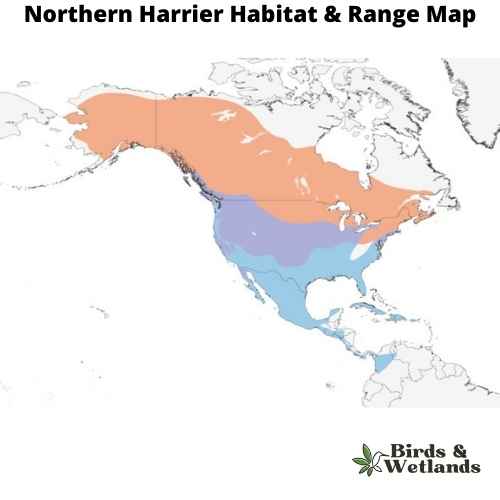
Listen:
The Northern Harrier is a medium-sized, slender hawk.
Adult birds are gray above, with pale bars on the wing feathers and white markings on the underwings and a white rump patch. The breast is barred with black and white, and the belly is streaked with brown.
They prefer open areas, such as grasslands and marshes, but can be found in almost any open habitat except dense woods.
Northern Harriers are opportunistic hunters that feed on small mammals such as mice, voles and rabbits as well as birds including quail, grouse and ducks. They hunt by flying low over open spaces such as fields or marshes.
Northern harrier nests on the ground in lowlands or hillsides near water bodies. It lays two to four eggs which hatch after 24 days of incubation by both parents. The chicks fledge after 30 days of hatching and remain dependent on their parents for another three weeks during which they learn how to fly.
Broad-winged Hawk (Buteo platypterus)

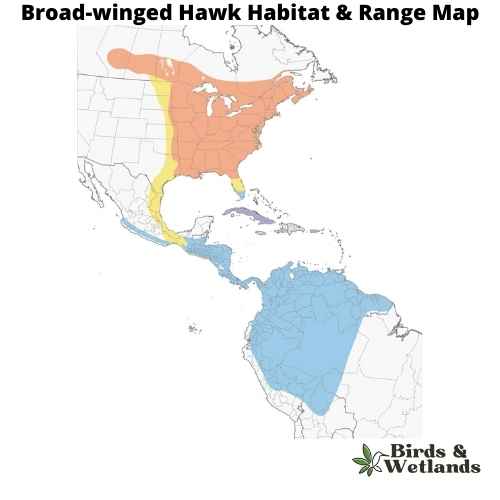
Broad-winged Hawk Sound
The Broad-winged Hawk holds a commanding presence as one of the largest hawks in the world, known for its broad wings. Its formidable size is a testament to its prowess as a bird of prey, effortlessly navigating the open skies in search of food.
Their distinctive appearance sets them apart. The adults exhibit a striking black and white pattern, complemented by a rusty breast and buff underparts and brown wings. In contrast, juveniles are adorned with a brown plumage, marked by pale edges on their feathers, adding to their distinctive youthful charm.
These hawks are most commonly found in open areas, such as farmlands or grasslands interspersed with scattered trees, which provide optimal conditions for when hawks hunt.
When it comes to their diet, Broad-winged Hawks feed on small rodents like mice, rats, squirrels, rabbits, and voles. Broad winged hawks breed during the spring and summer months then migrate to central and south America.
Swainson’s Hawk (Buteo swainsoni)
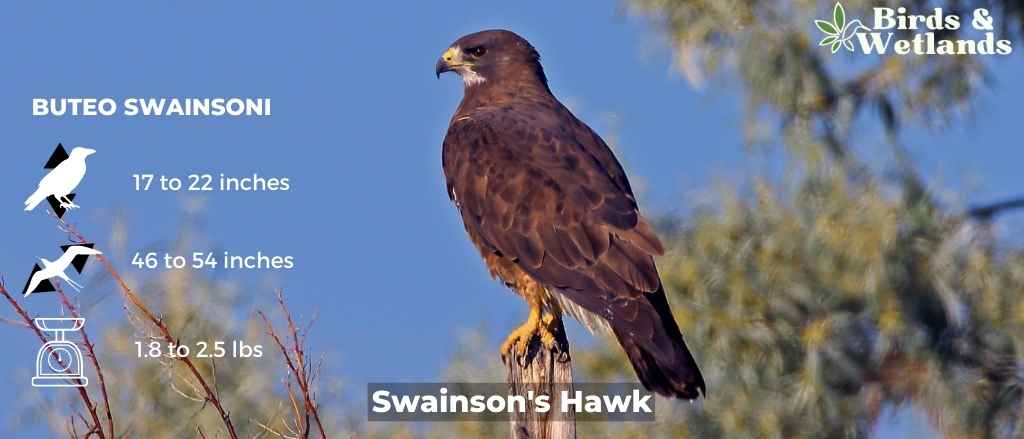
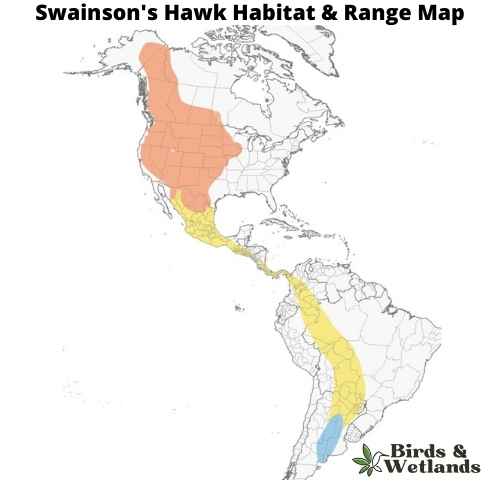
Listen: Swainson’s Hawk
Swainson’s Hawk is a medium-sized hawk that is found in North America and South America, Scientific Name: Buteo swainsoni.
The bird has a blue-gray plumage with a dark brown back, wings, and tail. It also has a white chest and belly. The beak and feet are black, but the eyes are yellow. They are often confused with Cooper’s Hawk because of similar coloring, but Swainson’s Hawks have wider tails and longer wings than their cousin species.
These birds eat small rodents such as gophers and mice. They also eat insects like grasshoppers and crickets during the summer months when they’re plentiful. They sometimes steal prey from other birds of prey such as Northern Harriers who hunt the same prey.
Swainson’s Hawks build nests on rocky cliffs near water sources where they can find food easily. They lay three to five eggs that hatch after about two months into fluffy brown baby hawks who leave the nest after about three weeks (or when they’re big enough).
Short-tailed Hawk (Buteo brachyurus)


Short-tailed Hawk Sound
Scientific Name: Buteo brachyurus
Length: 15.3-17.3 in
Wingspan: 32.7-40.5 in
Weight: 13.6-16.9 oz
The Short-tailed Hawk is a small to medium-sized bird of prey native to the Americas.
Short-tailed Hawks are distinctive for their size and color variations. Adult individuals usually measure between 33-41 centimeters in length, with relatively short tails, giving them their common name. This species exhibits two color morphs, a dark morph and a light morph, with the darker morph being more prevalent in some areas. Both morphs possess a white rump and a broad, rounded wing shape.
The diet of the Short-tailed Hawk primarily consists of other birds, which they catch with a unique hunting strategy. They are often seen soaring high in the sky and will plummet in a fast stoop to capture prey unaware. This bird of prey is a master at utilizing thermals to soar high in the sky and can often be found circling in the air on warm days.
Short-tailed Hawks typically lay 1-3 eggs. The female incubates the eggs while the male brings her food. After hatching, the young birds stay in the nest for several weeks, with both parents providing food until they are ready to fledge.
Rough-legged Hawk (Buteo lagopus)

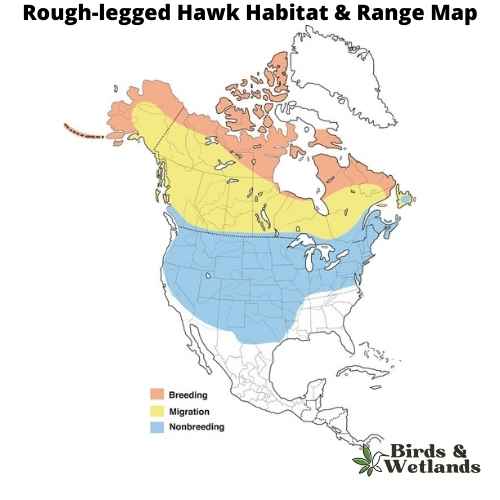
Rough-legged Hawk Sound
The Rough-legged Hawk is a large, raptor that is native to North America. It is also known as the American Rough-legged Hawk. Scientific Name: Buteo lagopus
The Rough-legged Hawk is a medium-sized hawk with a distinctive appearance, with dark brown feathers on its back and light brown feathers on its underside and broad thin wings. The hawk’s legs are also covered in dark feathers, which help to distinguish it from other species of hawk. The tail is barred with black and white. They have yellow eyes and dark feet.
Rough-legged Hawks hunt from above ground level, swooping down to catch its prey in its talons. When hunting for food, they prefer to eat small mammals such as squirrels and rabbits but will also eat birds if there aren’t any small mammals available. Although they eat a variety of small animals including birds, rodents, bats and reptiles, they rely heavily on fish for food during breeding season because it provides them with protein and calcium needed to produce eggs.
White-tailed Hawk (Geranoaetus albicaudatus)

The white-tailed hawk is a medium-sized bird of prey found in North America. It is one of the most common hawks on the continent, and it is often seen soaring high above the ground on its long wings.
- Scientific Name: Geranoaetus albicaudatus
- Length: 44–60 cm (17–24 in)
- Wingspan: 118–143 cm (46–56 in)
- Weight: 880–1,240 g (1.94–2.73 lb)
White-tailed Hawk Description
The white-tailed hawk has a large body and broad wings, with a tail that is mostly white with black bars. The head is grayish-brown, and there are white streaks above the eyes. The breast is grayish, while the belly is brownish-gray. The feathers on the back are dark brown with pale edges. The underwing coverts are white with brown tips. The white-tailed hawk has a black bill and brown legs. The eyes are yellow or orange with red orbital rings.
White-tailed Hawk Sound
White-tailed Hawk Habitat & Range
White-tailed hawks live in open country, including fields, deserts, grasslands, and even mountains. They like flat areas to hunt from so they can see their prey from far away. It can be found as far north as Canada and as far south as Mexico.

White-tailed Hawk Diet
White-tailed hawks eat small animals like mice, rats, rabbits, squirrels, birds (including chickens), reptiles (like snakes), amphibians (like frogs or toads), insects like grasshoppers and beetles as well as carrion (dead animals) such as road-killed deer or raccoons.
White-tailed Hawk Nesting
The White-tailed Hawk nests in tree cavities or on the ground, depending on the location. The female lays two eggs at a time and incubates them while the male hunts for food. After about two months, the eggs hatch and both parents take turns feeding their young until they are old enough to leave the nest on their own.
Northern Goshawk (Accipiter gentilis)


Listen:
The Northern Goshawk is a medium-sized hawk that is found in North America, Europe and Asia. It has brown eyes, a large sharp beak, and dark brown plumage on its upperparts and head, with white underparts that are spotted with brown barring. Its tail feathers are grayish-black with a dark band near the tip.
Northern goshawks eat squirrels, rabbits, grouse, woodchucks and other small mammals like voles or mice (which they often eat whole). They will also take larger prey such as deer fawns or even adult deer if they have no other choice. They have broad wings with long feathers that allow them to glide through the air when they catch their prey. They also have an excellent sense of smell which helps them locate their food source.
The Northern Goshawk builds its nest in a tree cavity or on a ledge, usually on the edge of an open area so it can easily see prey below. The female lays 3 to 5 eggs over two days and incubates them for 28 to 30 days while the male brings food to her every few hours until they hatch. The young fledge after about 6 weeks and leave the nest when they are about 10 weeks old.
Ferruginous Hawk (Buteo regalis)

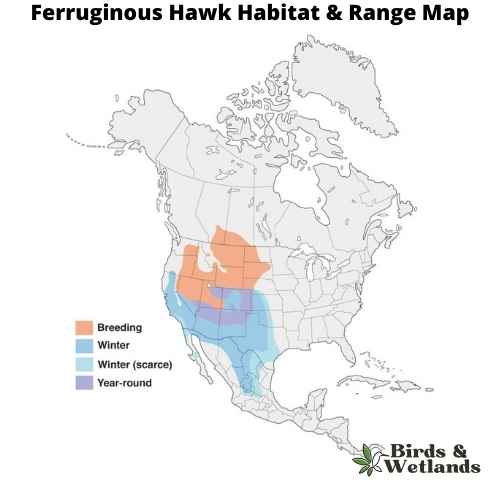
Ferruginous Hawk Sound
Scientific Name: Buteo regalis
Length: 20 to 27 in
Wingspan: 48 to 60 in
Weight: 32.0 to 80.0 oz
The Ferruginous Hawkis the largest hawk species native to North America. Known for its distinctive coloration and impressive size, this bird of prey predominantly inhabits the open landscapes of the western United States and parts of Canada.
Ferruginous Hawks are notable for their “ferruginous” or rust-colored back and shoulders, which contrasts sharply with the bird’s white underside. The hawk also has broad, rounded wings and a large, gape-mouthed beak. Ferruginous hawks exhibit dark morph and light morphs. Dark morphs have dark brown plumage, while light morphs display lighter, reddish-brown plumage. Morphs vary geographically.
Primarily feeding on small to medium sized mammals like rabbits and prairie dogs, the Ferruginous Hawk is an agile hunter, often seen soaring high above the ground or perched prominently while scanning for prey. It occasionally feeds on birds, reptiles, and insects as well.
Nesting for Ferruginous Hawks typically occurs on cliffs, hillsides, or large trees. The female lays between 2 to 5 eggs, and both parents share in the incubation and rearing of the chicks. The Ferruginous Hawk is a relatively solitary bird outside of the breeding season, and its call is a loud, high-pitched scream, often heard during courtship or near the nest.
Where to Spot Hawks in Florida
Cape Florida State Park
Located on Key Biscayne near Miami, Cape Florida State Park is a prime location for hawk-watching. It offers a diverse range of habitats, including coastal dunes, hardwood hammocks, and seagrass beds. This variety attracts various hawk species, including the Cooper’s Hawk, Red-shouldered Hawk, and the occasional Peregrine Falcon.
Paynes Prairie Preserve State Park
Situated in Micanopy, just south of Gainesville, Paynes Prairie Preserve is a vast and diverse wildlife haven. The park features wetlands, prairies, and hammocks, providing habitat for numerous bird species, including hawks. Red-tailed Hawks, Red-shouldered Hawks, and Northern Harriers can be spotted soaring above the prairies, while wooded areas may offer sightings of Cooper’s Hawks and Sharp-shinned Hawks.


